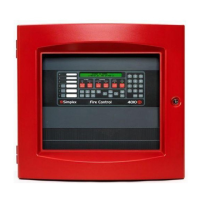4100-3204 Wiring
Note:
The information in this section is also applicable to the 4010-9908 4-Point AUX Relay Card (4010ES)
The 4100-3204 Relay Module includes 4 relays, each rated at 2 A. Each relay controls two sets of contacts and a separate 3 A fuse protects each set of
contacts. Four unsupervised feedback circuits, which are typically used to determine the state of a separate set of contacts (such as the sail switch on a
damper), are also provided. For battery calculation purposes, the module draws 18 mA in the normal supervisory condition and 70 mA with the relays
activated.
All contacts are Form C, dry contacts, meaning the Common terminal is connected to the Normally Closed terminal when the relay's coil is in the de-
energized state. The card's 30 VDC load capacity is 2 A* resistive/0.5 A inductive, and its 120 VAC load capacity is 0.5 A resistive/ 0.5 A inductive. The
feedback circuits are rated at 24 VDC, 850 uA maximum short circuit current, with maximum line resistance of 100 Ohms. The feedback circuit is
power-limited and intended for connection to contacts only. If the relay contacts are not switching power from the MSS, MSS2, ESS (4010ES), UPS, SPS,
XPS, RPS, ES-PS or ES-XPS for 4100ES systems; SPS, XPS, RPS, EPS, UPS for legacy 4100 systems or 4100-1108 power supply, or a power-limited power
supply that is UL-listed for fire protective signaling use, the feedback circuits are non-power-limited. Refer to for the designations of the contacts and
feedback circuits.
Figure 17: 4100-3204 Relay Module Wiring
Table 2: 4100-3204 Relay Module Wiring details
Relay Fuse Contacts
TB1-16 NC
TB1-15 NOF1 RELAY 1A
TB1-14 C
TB1-13 NC
TB1-12 NO
K1
F2 RELAY 1B
TB1-11 C
TB1-10 NC
TB1-9 NOF3 RELAY 2A
TB1-8 C
TB1-7 NC
TB1-6 NO
K2
F4 RELAY 2B
TB1-5 C
TB1-32 NC
TB1-31 NOF5 RELAY 3A
TB1-30 C
TB1-29 NC
TB1-28 NO
K3
F6 RELAY 3B
TB1-27 C
TB1-26 NC
TB1-25 NOF7 RELAY 4A
TB1-24 C
TB1-23 NC
TB1-22 NO
K4
F8 RELAY 4B
TB1-21 C
*Also 2 A at 30 VAC, non-inductive.
page 20 579-220 Rev. F
4100/4120- Series and 4010ES Relay Modules Installation Instructions

